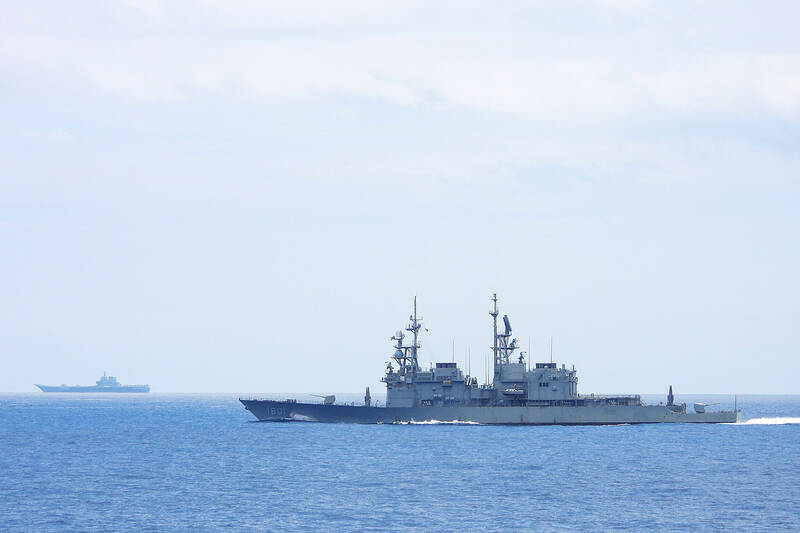The increased frequency of China’s military activities around Taiwan has raised the risk of events “getting out of hand” and sparking an accidental clash, Minister of National Defense Chiu Kuo-cheng (邱國正) said yesterday.
In the past two weeks dozens of fighters, drones, bombers and other aircraft, as well as warships and the Chinese aircraft carrier Shandong, have operated nearby, Taiwan has said.
China has in the past few years carried out many such drills around Taiwan.

Photo: AFP / handout / Ministry of National Defense
Asked by reporters on the sidelines of the legislature’s plenary session whether there was a risk of an accidental incident sparking a broader conflict given the frequency of China’s activities, Chiu said that “this is something we are very worried about.”
Warships from China’s southern and eastern theater commands have been operating together off Taiwan’s east coast, he added.
“The risks of activities involving aircraft, ships and weapons will increase, and both sides must pay attention,” Chiu said.
China has not commented on the drills around Taiwan, and the Chinese Ministry of National Defense has not responded to requests for comment.
Chiu said that when the Shandong was at sea, which Taiwan first reported on Monday last week, it was operating as the “opposing force” in the drills.
China’s Eastern Theater Command was the “attacking force,” simulating a battle scenario, Taiwan’s Ministry of National Defense spokesman Major General Sun Li-fang (孫立方) said.
Taiwan’s traditional military planning for a potential conflict has been to use its mountainous east coast, especially the two major air bases there, as a place to regroup and preserve its forces given it does not directly face China unlike the west coast.
However, China has increasingly been flexing its muscles off Taiwan’s east coast, and generally displaying its ability to operate much further away from its own coastline.
China normally performs large-scale exercises from July to September, Taiwan’s ministry said.
The ministry yesterday said that China had largely dialed back its drills, reporting that over the previous 24-hour period it had only spotted two Chinese aircraft operating in its air defense identification zone.
Taipei has said that it would remain calm and not escalate the situation, but it would not allow “repeated provocations” from China, whose forces have so far not entered Taiwan’s territorial seas or airspace.
In related news, US Secretary of State Antony Blinken, Japanese Minister for Foreign Affairs Yoko Kamikawa, Australian Minister for Foreign Affairs Penny Wong (黃英賢) and Indian Minister of External Affairs Subrahmanyam Jaishankar on Friday reaffirmed their countries’ opposition to any unilateral attempts to change the “status quo” in the Indo-Pacific region.
The ministers from the Quadrilateral Security Dialogue (Quad) grouping of nations made the statement during a meeting on the sidelines of the UN General Assembly in New York.
“The Quad reiterates its steadfast commitment to a free and open Indo-Pacific that is inclusive and resilient,” a joint readout of their meeting said.
“We reaffirm our conviction that international law, respect for sovereignty and territorial integrity, and the maintenance of peace and security in the maritime domain underpin the development and prosperity of the Indo-Pacific,” it said. “We emphasize that disputes should be resolved peacefully and in accordance with international law, without the threat or use of force.”
Additional reporting by staff writer

The US government has signed defense cooperation agreements with Japan and the Philippines to boost the deterrence capabilities of countries in the first island chain, a report by the National Security Bureau (NSB) showed. The main countries on the first island chain include the two nations and Taiwan. The bureau is to present the report at a meeting of the legislature’s Foreign Affairs and National Defense Committee tomorrow. The US military has deployed Typhon missile systems to Japan’s Yamaguchi Prefecture and Zambales province in the Philippines during their joint military exercises. It has also installed NMESIS anti-ship systems in Japan’s Okinawa

‘WIN-WIN’: The Philippines, and central and eastern European countries are important potential drone cooperation partners, Minister of Foreign Affairs Lin Chia-lung said Minister of Foreign Affairs Lin Chia-lung (林佳龍) in an interview published yesterday confirmed that there are joint ventures between Taiwan and Poland in the drone industry. Lin made the remark in an exclusive interview with the Chinese-language Liberty Times (the Taipei Times’ sister paper). The government-backed Taiwan Excellence Drone International Business Opportunities Alliance and the Polish Chamber of Unmanned Systems on Wednesday last week signed a memorandum of understanding in Poland to develop a “non-China” supply chain for drones and work together on key technologies. Asked if Taiwan prioritized Poland among central and eastern European countries in drone collaboration, Lin

NO CONFIDENCE MOTION? The premier said that being toppled by the legislature for defending the Constitution would be a democratic badge of honor for him Premier Cho Jung-tai (卓榮泰) yesterday announced that the Cabinet would not countersign the amendments to the local revenue-sharing law passed by the Legislative Yuan last month. Cho said the decision not to countersign the amendments to the Act Governing the Allocation of Government Revenues and Expenditures (財政收支劃分法) was made in accordance with the Constitution. “The decision aims to safeguard our Constitution,” he said. The Constitution stipulates the president shall, in accordance with law, promulgate laws and issue mandates with the countersignature of the head of the Executive Yuan, or with the countersignatures of both the head of the Executive Yuan and ministers or

CABINET APPROVAL: People seeking assisted reproduction must be assessed to determine whether they would be adequate parents, the planned changes say Proposed amendments to the Assisted Reproduction Act (人工生殖法) advanced yesterday by the Executive Yuan would grant married lesbian couples and single women access to legal assisted reproductive services. The proposed revisions are “based on the fundamental principle of respecting women’s reproductive autonomy,” Cabinet spokesperson Michelle Lee (李慧芝) quoted Vice Premier Cheng Li-chiun (鄭麗君), who presided over a Cabinet meeting earlier yesterday, as saying at the briefing. The draft amendment would be submitted to the legislature for review. The Ministry of Health and Welfare, which proposed the amendments, said that experts on children’s rights, gender equality, law and medicine attended cross-disciplinary meetings, adding that